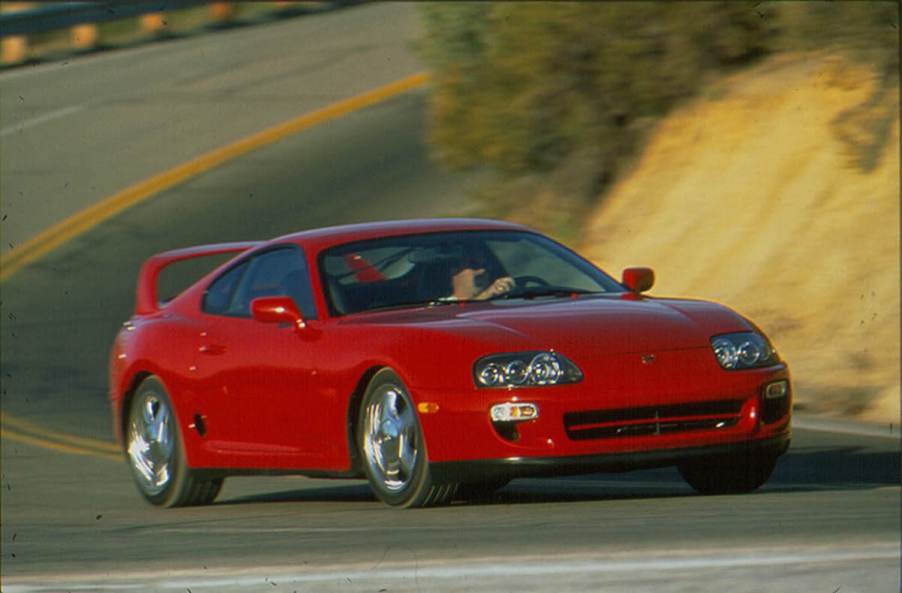
Was the Mk4 Toyota Supra As Legendary As Everyone Thinks?
We love Japanese sports cars from the 90s era as much many other enthusiasts. The first-generation Acura NSX makes us shudder every time we see one, the Toyota MR2 is still a head-turner, and the fourth-generation Supra is a legend in our minds. But to that last point, is the Supra really as great as we – and most enthusiasts – think it is? A recent video from SavageGeese aimed to answer that question.
What made the fourth-generation Toyota Supra so great?

The fourth-generation Toyota Supra was produced in the U.S. from 1993 to 1998, and it was one of the most formidable sports cars the Japanese automaker ever produced. During its development, Toyota’s product planners invited journalists to drive the car and its rivals and give their feedback on everything from aesthetics to performance. Ultimately, the car that debuted in 1993 was a culmination of all of the feedback Toyota received.
The Mk4 Supra shared its platform with the Lexus SC in the U.S., but it was 13 inches shorter than its luxurious corporate cousin. It also had a double wishbone/multilink suspension, four-wheel disc brakes, and ABS. However, the real star of the show was found under the hood.
The fourth-gen Supra was powered by the almighty 2JZ engine, which made 220 hp in naturally aspirated form (2JZ-GE). That engine could be found in the base-model Supra and mated to either a four-speed automatic or five-speed manual transmission. Although that engine proved to have enough power for normal driving conditions, the real hero was the 2JZ-GTE engine in the Supra Turbo models.
The twin-turbocharged 3.0-liter engine made 320 hp and 318 lb-ft of torque, which could propel the car from 0 to 60 mph in just 4.6 seconds. That’s quicker than the current Toyota GR Supra 2.0 (5 seconds) but slightly slower than the GR Supra 3.0 (3.9 seconds).
On top of that factory-tuned performance, many import car enthusiasts and specialized tuners have been able to extract 1,000 horsepower out of the Supra’s 2JZ engine with relative ease. Hence the car’s current legendary status – or at least that’s how a lot of car lovers see it.
Is the Mk4 Toyota Supra really that legendary?
In some ways, the fourth-generation Toyota Supra is legendary as it was ahead of its time. In addition to its quick acceleration performance, the Supra stopped shorter than most performance cars at the time and pulled 0.95 g on the skid pad. It was quite the performer but also very expensive – costing nearly $50,000 in the mid-90s. That said, its sales dwindled, and Toyota had to discontinue it.
Fast forward to today, and most car fans may wonder how the fabled Supra has held up. According to the hosts of the Savagegeese YouTube channel, “it’s soft.” More specifically, the car has a lot of body roll, and the rear end “never particularly sets” after a hard corner.
Of course, the hosts were driving the car on a race track and noted that it comes alive at higher speeds. They noted that the twin-turbo engine’s stock power is “more than adequate,” but could see how a few suspension and tire modifications could do the car a lot of good.
All things considered, the fourth-generation Supra was legendary during its time, but by today’s standards, it’s pretty dated.
Is the fourth-generation Supra worth the astronomical price it’s going for now?

In a word, no. All things considered, the fourth-generation is not worth the $60,000 to $200,000 price tags its selling for in today’s market. It’s a great car, but those prices are mainly due to nostalgic hype in comparison to its actual performance.
“Mechanically, this is peak Toyota; this is what everybody wants from the Toyota brand. Hardcore overthought engineering that’s bulletproof,” said Mark from SavageGeese. “But compared to modern engineering, it’s nowhere near as fast, it’s nowhere near as fun, and it’s not as edgy. You have to modify the hell out of it.”
That said, if you have always wanted an Mk4 Supra and have a ton of money burning a hole in your bank account – go for it. If not, we suggest spending a fraction of the cost and buying a new GR Super instead.





